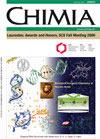用分子包封法提高水溶液中红色荧光团的亮度。
IF 1.6
4区 化学
Q3 CHEMISTRY, MULTIDISCIPLINARY
引用次数: 0
摘要
生物分子环境中的荧光光谱和显微镜通常在水溶液中进行,最好使用发红染料。然而,水会熄灭它们的荧光。我们在这篇文章中探讨了红色荧光团和大环(如环糊精和葫芦酚)之间的主客体相互作用如何通过屏蔽染料免受水的影响来防止猝灭,从而提高它们的亮度。我们成功地将该策略应用于超分辨率成像。本文章由计算机程序翻译,如有差异,请以英文原文为准。
Enhancing the Brightness of Red-emitting Fluorophores in Aqueous Solution by Molecular Encapsulation.
Fluorescence spectroscopy and microscopy in biomolecular environments are usually performed in aqueous solution and preferably using red-emitting dyes. However, water quenches their fluorescence. We explore in this contribution how host-guest interactions between red-emitting fluorophores and macrocycles such as cyclodextrins and cucurbiturils can prevent quenching by shielding the dyes from water, thereby enhancing their brightness. We successfully apply this strategy in super-resolution imaging.
求助全文
通过发布文献求助,成功后即可免费获取论文全文。
去求助
来源期刊

Chimia
化学-化学综合
CiteScore
1.60
自引率
0.00%
发文量
144
审稿时长
2 months
期刊介绍:
CHIMIA, a scientific journal for chemistry in the broadest sense covers the interests of a wide and diverse readership. Contributions from all fields of chemistry and related areas are considered for publication in the form of Review Articles and Notes. A characteristic feature of CHIMIA are the thematic issues, each devoted to an area of great current significance.
 求助内容:
求助内容: 应助结果提醒方式:
应助结果提醒方式:


